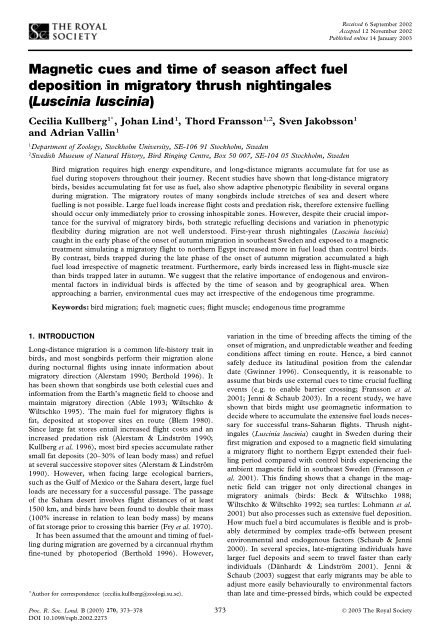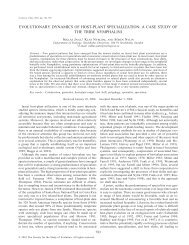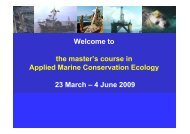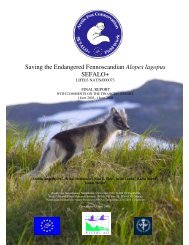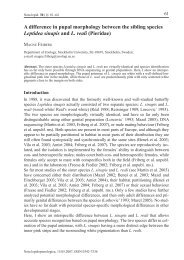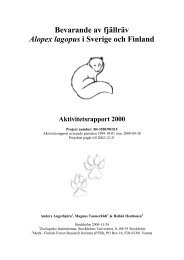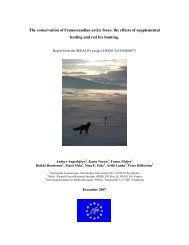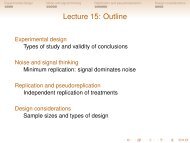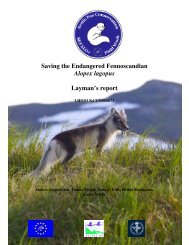Kullberg et al 2003
Kullberg et al 2003
Kullberg et al 2003
- No tags were found...
You also want an ePaper? Increase the reach of your titles
YUMPU automatically turns print PDFs into web optimized ePapers that Google loves.
Received 6 September 2002Accepted 12 November 2002Published online 14 January <strong>2003</strong>Magn<strong>et</strong>ic cues and time of season affect fueldeposition in migratory thrush nighting<strong>al</strong>es(Luscinia luscinia)Cecilia <strong>Kullberg</strong> 1* , Johan Lind 1 , Thord Fransson 1,2 , Sven Jakobsson 1and Adrian V<strong>al</strong>lin 11Department of Zoology, Stockholm University, SE-106 91 Stockholm, Sweden2Swedish Museum of Natur<strong>al</strong> History, Bird Ringing Centre, Box 50 007, SE-104 05 Stockholm, SwedenBird migration requires high energy expenditure, and long-distance migrants accumulate fat for use asfuel during stopovers throughout their journey. Recent studies have shown that long-distance migratorybirds, besides accumulating fat for use as fuel, <strong>al</strong>so show adaptive phenotypic flexibility in sever<strong>al</strong> organsduring migration. The migratory routes of many songbirds include str<strong>et</strong>ches of sea and desert wherefuelling is not possible. Large fuel loads increase flight costs and predation risk, therefore extensive fuellingshould occur only immediately prior to crossing inhospitable zones. However, despite their cruci<strong>al</strong> importancefor the surviv<strong>al</strong> of migratory birds, both strategic refuelling decisions and variation in phenotypicflexibility during migration are not well understood. First-year thrush nighting<strong>al</strong>es (Luscinia luscinia)caught in the early phase of the ons<strong>et</strong> of autumn migration in southeast Sweden and exposed to a magn<strong>et</strong>ictreatment simulating a migratory flight to northern Egypt increased more in fuel load than control birds.By contrast, birds trapped during the late phase of the ons<strong>et</strong> of autumn migration accumulated a highfuel load irrespective of magn<strong>et</strong>ic treatment. Furthermore, early birds increased less in flight-muscle siz<strong>et</strong>han birds trapped later in autumn. We suggest that the relative importance of endogenous and environment<strong>al</strong>factors in individu<strong>al</strong> birds is affected by the time of season and by geographic<strong>al</strong> area. Whenapproaching a barrier, environment<strong>al</strong> cues may act irrespective of the endogenous time programme.Keywords: bird migration; fuel; magn<strong>et</strong>ic cues; flight muscle; endogenous time programme1. INTRODUCTIONLong-distance migration is a common life-history trait inbirds, and most songbirds perform their migration <strong>al</strong>oneduring nocturn<strong>al</strong> flights using innate information aboutmigratory direction (Alerstam 1990; Berthold 1996). Ithas been shown that songbirds use both celesti<strong>al</strong> cues andinformation from the Earth’s magn<strong>et</strong>ic field to choose andmaintain migratory direction (Able 1993; Wiltschko &Wiltschko 1995). The main fuel for migratory flights isfat, deposited at stopover sites en route (Blem 1980).Since large fat stores entail increased flight costs and anincreased predation risk (Alerstam & Lindström 1990;<strong>Kullberg</strong> <strong>et</strong> <strong>al</strong>. 1996), most bird species accumulate rathersm<strong>al</strong>l fat deposits (20–30% of lean body mass) and refuelat sever<strong>al</strong> successive stopover sites (Alerstam & Lindström1990). However, when facing large ecologic<strong>al</strong> barriers,such as the Gulf of Mexico or the Sahara desert, large fuelloads are necessary for a successful passage. The passageof the Sahara desert involves flight distances of at least1500 km, and birds have been found to double their mass(100% increase in relation to lean body mass) by meansof fat storage prior to crossing this barrier (Fry <strong>et</strong> <strong>al</strong>. 1970).It has been assumed that the amount and timing of fuellingduring migration are governed by a circannu<strong>al</strong> rhythmfine-tuned by photoperiod (Berthold 1996). However,*Author for correspondence (cecilia.kullberg@zoologi.su.se).variation in the time of breeding affects the timing of theons<strong>et</strong> of migration, and unpredictable weather and feedingconditions affect timing en route. Hence, a bird cannotsafely deduce its latitudin<strong>al</strong> position from the c<strong>al</strong>endardate (Gwinner 1996). Consequently, it is reasonable toassume that birds use extern<strong>al</strong> cues to time cruci<strong>al</strong> fuellingevents (e.g. to enable barrier crossing; Fransson <strong>et</strong> <strong>al</strong>.2001; Jenni & Schaub <strong>2003</strong>). In a recent study, we haveshown that birds might use geomagn<strong>et</strong>ic information todecide where to accumulate the extensive fuel loads necessaryfor successful trans-Saharan flights. Thrush nighting<strong>al</strong>es(Luscinia luscinia) caught in Sweden during theirfirst migration and exposed to a magn<strong>et</strong>ic field simulatinga migratory flight to northern Egypt extended their fuellingperiod compared with control birds experiencing theambient magn<strong>et</strong>ic field in southeast Sweden (Fransson <strong>et</strong><strong>al</strong>. 2001). This finding shows that a change in the magn<strong>et</strong>icfield can trigger not only direction<strong>al</strong> changes inmigratory anim<strong>al</strong>s (birds: Beck & Wiltschko 1988;Wiltschko & Wiltschko 1992; sea turtles: Lohmann <strong>et</strong> <strong>al</strong>.2001) but <strong>al</strong>so processes such as extensive fuel deposition.How much fuel a bird accumulates is flexible and is probablyd<strong>et</strong>ermined by complex trade-offs b<strong>et</strong>ween presentenvironment<strong>al</strong> and endogenous factors (Schaub & Jenni2000). In sever<strong>al</strong> species, late-migrating individu<strong>al</strong>s havelarger fuel deposits and seem to travel faster than earlyindividu<strong>al</strong>s (Dänhardt & Lindström 2001). Jenni &Schaub (<strong>2003</strong>) suggest that early migrants may be able toadjust more easily behaviour<strong>al</strong>ly to environment<strong>al</strong> factorsthan late and time-pressed birds, which could be expectedÓ Proc. R. Soc. Lond. B (<strong>2003</strong>) 270, 373–378 373 <strong>2003</strong> The Roy<strong>al</strong> Soci<strong>et</strong>yDOI 10.1098/rspb.2002.2273
374 C. <strong>Kullberg</strong> and others Cues for extensive refuelling in thrush nighting<strong>al</strong>esto be more controlled by their endogenous time programme.Besides accumulating fuel, birds <strong>al</strong>so show adaptivephenotypic flexibility in sever<strong>al</strong> organs during migration.Dissections of individu<strong>al</strong>s of sever<strong>al</strong> species, sampled atdifferent periods during migration, have shown that flightmusclemass often increases before migratory flights whil<strong>et</strong>he size of various nutrition<strong>al</strong> organs is reduced (Piersma1998), presumably to increase flight-muscle size relative towing load during extensive migratory flights (Pennycuick1989). An enlarged flight muscle may <strong>al</strong>so serve toincrease protein sources before long-distance migration(Bauchinger & Biebach 1998, 2001; Jenni & Jenni-Eiermann1998). How interactions b<strong>et</strong>ween endogenous andextern<strong>al</strong> factors in late and early migrants may affect birds’bodily changes is not well understood ( Jenni & Schaub<strong>2003</strong>).In order to study wh<strong>et</strong>her changes in the size of fuel loadand flight muscle depend on the time within the migratoryseason, we replicated our study of migratory fuelling inrelation to geomagn<strong>et</strong>ic cues in first-year thrush nighting<strong>al</strong>es(Fransson <strong>et</strong> <strong>al</strong>. 2001). Because the experiments inboth years (2000 and 2001) were performed in two replicatesduring autumn, when thrush nighting<strong>al</strong>es leaveSweden (birds in the first replicate were trapped early andthose in the second replicate were trapped late during theons<strong>et</strong> of autumn migration), it is possible to study theeffects of both timing of migration and magn<strong>et</strong>ic informationon fuelling decisions. We <strong>al</strong>so investigated how theincrease in body mass during the fuelling period affectsthe size of the pector<strong>al</strong> muscle by measuring the muscleof <strong>al</strong>l birds in 2001 at the beginning and end of the experimentusing a non-invasive technique.2. MATERIAL AND METHODS(a) SubjectsThrush nighting<strong>al</strong>es were trapped by mist n<strong>et</strong>s during August2000 and 2001, in the vicinity of Tov<strong>et</strong>orp Zoologic<strong>al</strong> ResearchStation, in southeast Sweden (58°569 N, 17°089 E). The effectsof age and, thereby, experience from earlier migration wereavoided by using only first-year birds in the study. Furthermore,only birds about to prepare for migration were included bychoosing individu<strong>al</strong>s that had compl<strong>et</strong>ed their post-juvenilemoult and had sm<strong>al</strong>l amounts of visible fat reserves (fat scores0–2 according to the sc<strong>al</strong>e in P<strong>et</strong>tersson & Hasselquist (1985)).(b) HusbandryIndividu<strong>al</strong> birds were randomly assigned either to a shed withmagn<strong>et</strong>ic coils, or to a shed with a wooden dummy coil wherebirds experienced the ambient magn<strong>et</strong>ic field. Both sheds(4 m ´ 4 m ´ 3.5 m) were built of non-magn<strong>et</strong>ic materi<strong>al</strong>s, andwere placed 15 m apart. Roofs were made of semi-transparentplastic, which <strong>al</strong>lowed some light through but blocked potenti<strong>al</strong>celesti<strong>al</strong> cues. To compensate for the reduction in light spectracaused by the plastic roof (Wiltschko <strong>et</strong> <strong>al</strong>. 1993), each shedhad two daylight bulbs (HP1-T Plus Philips Powertone 400 W)following the natur<strong>al</strong> daylight. In each shed, four birds werehoused in separate cages (55 cm ´ 55 cm ´ 55 cm), and bafflesof sound-absorbing materi<strong>al</strong> were placed b<strong>et</strong>ween the cages toreduce sound transmission and to separate the birds visu<strong>al</strong>ly.Birds were fed with me<strong>al</strong>worms (Tenebrio molitor), a dry foodmixture (Berthold <strong>et</strong> <strong>al</strong>. 1990) and water ad libitum. Food andFigure 1. All autumn recoveries of thrush nighting<strong>al</strong>es in theeastern Mediterranean area that were ringed in Denmark(n = 5), Sweden (n = 9) or Finland (n = 5). Data receivedfrom the Zoologic<strong>al</strong> Museum in Copenhagen, the SwedishMuseum of Natur<strong>al</strong> History and the Finnish Museum ofNatur<strong>al</strong> History.water were exchanged daily. Food trays were placed on sc<strong>al</strong>es(Precisa 310C) connected to computers, <strong>al</strong>lowing automatic andcontinuous registration of individu<strong>al</strong> body mass. When c<strong>al</strong>culatingthe increase in body mass, weights at 20.00 were used.(c) TreatmentsControl birds experienced no manipulation of the magn<strong>et</strong>icfield during the whole experiment, which ran for 11 days. Atthe start of the experiment, morning day 1 (trapping day), bothexperiment<strong>al</strong> and control birds remained in the ambient magn<strong>et</strong>icfield (tot<strong>al</strong> intensity of 50 800 nT; inclination of 72°209).In order to simulate the gradu<strong>al</strong> change in magn<strong>et</strong>ic field thatbirds experience during migration, the field of the experiment<strong>al</strong>birds was changed to that of four different loc<strong>al</strong>ities during thecourse of the experiment, c<strong>al</strong>culated according to IGRF2000(Internation<strong>al</strong> Association of Geomagn<strong>et</strong>ism and Aeronomy2000). We based the simulated migration on data from autumnrecoveries of thrush nighting<strong>al</strong>es ringed in Denmark, Swedenand Finland. Since <strong>al</strong>l recoveries are found in northern Egypt(figure 1), suggesting they prepare for crossing the Sahara desertin this area, we simulated a migratory route from Sweden tonorthern Egypt for the experiment<strong>al</strong> birds. The autumnrecoveries available indicate that this migratory trip lasts forProc. R. Soc. Lond. B (<strong>2003</strong>)
Cues for extensive refuelling in thrush nighting<strong>al</strong>es C. <strong>Kullberg</strong> and others 375approximately one month. At evening day 1 the magn<strong>et</strong>ic fieldof the experiment<strong>al</strong> birds was changed to that of northernPoland (49 900 nT, 69°309), at evening day 2 the magn<strong>et</strong>ic fieldwas changed to that of southern Poland (48 900 nT, 65°509), atevening day 4 the magn<strong>et</strong>ic field was changed to that of northernGreece (46 400 nT, 57°209) and at evening day 6 the magn<strong>et</strong>icfield was changed to that of northern Egypt (43 200 nT,45°109). Experiment<strong>al</strong> birds then remained in the magn<strong>et</strong>ic fieldof northern Egypt (31°009 N, 29°009 E) until the end of theexperiment at day 11 when <strong>al</strong>l birds were released into the wild.This protocol was replicated once each year, thus 16 birds weresubjected to the magn<strong>et</strong>ic treatment and 16 birds were used ascontrols. Birds for the first replicate each year were trapped on5 August (± 2 days) while birds in the second replicate wer<strong>et</strong>rapped on 19 August (± 2 days). The number of trapped thrushnighting<strong>al</strong>es per day during the autumn (1990–2001) at a birdobservatory in southeast Sweden (56°559 N, 18°119 E) gives amedian date for the ons<strong>et</strong> of autumn migration of 13 August(90% of the birds were trapped b<strong>et</strong>ween 30 July and 19 August,n = 143, Sundre Bird Ringing Group, unpublished data). Thus,birds used in the first replicate were trapped in the early phaseof the ons<strong>et</strong> of autumn migration while birds used in the secondreplicate were trapped late in the ons<strong>et</strong> of migration.(d) The magn<strong>et</strong>ic coilTo generate a volume of 1.2 m 3 , in which four caged birdscould be subjected to a manipulated homogenous magn<strong>et</strong>icfield, we constructed a magn<strong>et</strong>ic coil system of <strong>al</strong>uminium profiles.The system consisted of two independent series of fourquadratic coils each, arranged orthogon<strong>al</strong>ly (Lohmann &Lohmann 1994). Since the difference in declination b<strong>et</strong>weensoutheast Sweden and northern Egypt is less than 1°, the declinationwas left unchanged.The magn<strong>et</strong>ic field of the coil system (2.4 m ´ 2.4 m´ 2.4 m) was c<strong>al</strong>culated using the Biot–Savart law. We found,numeric<strong>al</strong>ly, a configuration of the coils giving an inhomogeneityof lower than 1% in the experiment<strong>al</strong> area. Coils were woundwith copper wire (0.7 mm diam<strong>et</strong>er), the four outer coils in 25turns and the four inner coils in 10 turns. By connecting eachof the two coil systems to a power supply (Delta Elektronika ES030-10) we could change the vertic<strong>al</strong> and horizont<strong>al</strong> componentsof the magn<strong>et</strong>ic field independently by changing the current(stability of the power supply = ± 0.0011 A).Before the experiment began, we s<strong>et</strong> the vertic<strong>al</strong> and horizont<strong>al</strong>components of the magn<strong>et</strong>ic field for the stopover sites, usinga fluxgate magn<strong>et</strong>om<strong>et</strong>er (Zeiss Jena theodolite with BartingtonInstruments fluxgate magn<strong>et</strong>om<strong>et</strong>er). Furthermore, we verifiedthe homogeneity of the field using a proton magn<strong>et</strong>om<strong>et</strong>er(GEM Systems). At this point, we <strong>al</strong>so checked that the fieldfrom one coil did not affect the field of the other more thanexpected, thus showing that the coils were sufficiently orientated.(e) Measurement of pector<strong>al</strong> muscle and wingloadIn order to study changes in the flight muscle, we measuredthe size of the pector<strong>al</strong> muscle of each bird in 2001 at trapping(day 1) and at the end of the experiment (day 11). The size ofthe muscle was estimated using a body mould in dent<strong>al</strong> <strong>al</strong>ginate(TopDent, DAB Dent<strong>al</strong>, Sweden) (Selman & Houston 1996).By cutting the mould dorsoventr<strong>al</strong>ly through the middle of thepector<strong>al</strong> muscle, we obtained a measure of the cross-section<strong>al</strong>area of the muscle, which was recorded by making four inkprints per mould on a paper. A horizont<strong>al</strong> line was drawn 6 mmperpendicular to the stern<strong>al</strong> keel of each print (6 mm being usedas a standard measure of keel depth, obtained from dissectionof a dead thrush nighting<strong>al</strong>e). The enclosed area was then measuredusing the computer program Scion Image For Windows,B<strong>et</strong>a 4.0.2; Scion Corporation, and an average area was c<strong>al</strong>culatedfor the four prints from each mould. The cross-section<strong>al</strong>pector<strong>al</strong>-muscle area established with this moulding techniquehas been shown to correlate with pector<strong>al</strong>-muscle lean dry massin zebra finches (Taeniopygia guttata) (Selman & Houston1996). Before making a mould, we examined each bird, therebyconfirming that subcutaneous fat did not cover the pector<strong>al</strong>muscle, which would have given an incorrect estimate ofpector<strong>al</strong>-muscle size. In order to c<strong>al</strong>culate wing load we tracedthe outline of the left wing of each bird at day 11. The area ofthe wing was then measured using the computer program ScionImage and the wing load of each bird was c<strong>al</strong>culated accordingto Pennycuick (1989). The muscle ratio for individu<strong>al</strong> birds wasc<strong>al</strong>culated as muscle area per wing load.3. RESULTSThere were no differences in either initi<strong>al</strong> body mass orwing length b<strong>et</strong>ween replicates (body mass: F 1 ,24 = 0.1,p = 0.8; wing length: F 1 ,2 4 = 0.1, p = 0.8), treatments (bodymass: F 1 ,24 = 0.6, p = 0.4; wing length: F 1,24 = 0.1, p = 0.8)or years (body mass: F 1 ,2 4 = 0.4, p = 0.5; wing length:F 1 ,2 4 = 3.8, p = 0.6) and <strong>al</strong>l birds increased in body massduring the study (ANOVA with body-mass increase fromday 1 as repeated measurement with 10 levels: F 9 ,21 6= 121.5, p , 0.001; table 1). Since birds in the early replicatesincreased less in body mass over time than did birdsin the late replicates (F 9 ,21 6 = 0.01, p , 0.05), while therewere no effects of year (F 1 ,24 = 0.01, p = 0.9), the two replicateswere treated separately. In the early replicate,experiment<strong>al</strong> birds experiencing the magn<strong>et</strong>ic treatmentincreased more in body mass than did control birds (table2). Experiment<strong>al</strong> birds increased by 8.5 ± 0.6 g (mean± s.e.) (32% body-mass increase) from day 1 to day 11,whereas control birds increased by 4.9 ± 0.5 g (19% bodymassincrease) (figure 2a). However, in the late replicat<strong>et</strong>he body mass of both experiment<strong>al</strong> and control birdsincreased substanti<strong>al</strong>ly (mean ± s.e. increase in body massfrom day 1 to day 11 for experiment<strong>al</strong> birds: 8.5 ± 1.0 g(34% body-mass increase); for control birds: 8.4 ± 0.7 g(32% body-mass increase); figure 2b). Furthermore,measurements of the pector<strong>al</strong> muscle of the thrush nighting<strong>al</strong>esin 2001 reve<strong>al</strong>ed that the muscle area increasedwith increasing wing load (effect of day; table 3) and thatthere was a difference in pector<strong>al</strong>-muscle change b<strong>et</strong>weenthe two replicates. The late replicate increased more inmuscle area from day 1 to day 11 than did the early replicate,resulting in a higher muscle ratio at the end of theexperiment (table 3; figure 3).4. DISCUSSIONData from the two successive years show that controlbirds experiencing the ambient magn<strong>et</strong>ic field in southeastSweden had higher fuel loads as the season progressed(early replicates versus late replicates). Furthermore, inthe early replicates, control birds showed a lower fueldeposition than did birds experiencing a magn<strong>et</strong>ic treat-Proc. R. Soc. Lond. B (<strong>2003</strong>)
376 C. <strong>Kullberg</strong> and others Cues for extensive refuelling in thrush nighting<strong>al</strong>esTable 1. Wing length, initi<strong>al</strong> body mass and tot<strong>al</strong> increase in body mass.(Mean ± s.e. wing length, initi<strong>al</strong> body mass and tot<strong>al</strong> increase in body mass during the study for the two years and treatments;the two replicates are combined.)tot<strong>al</strong> increase in body massyear treatment wing length (mm) initi<strong>al</strong> body mass (g) (g) day 1–day 112000 control 89.4 ± 0.8 23.5 ± 0.3 6.4 ± 1.02000 experiment 88.7 ± 0.7 22.9 ± 0.4 8.6 ± 0.72001 control 90.2 ± 0.6 22.9 ± 0.5 6.8 ± 0.82001 experiment 90.5 ± 0.6 22.9 ± 0.3 8.4 ± 0.9Table 2. Increase in body mass from day 1.(Statistics from ANOVAs for early and late replicates, respectively. Factors: 1, treatment; 2, year; 3, day (repeated measurementfactor with 10 levels; day 2–11); and the subsequent interactions.)early replicatelate replicatefactor d.f. effect, d.f. error F p F p´´´1 1, 12 8.1 0.015 0.1 0.82 1, 12 0.1 0.7 0.1 0.73 9, 108 50.0 , 0.001 72.1 , 0.0011 2 1, 12 0.3 0.6 1.0 0.31 3 9, 108 2.3 0.02 0.8 0.62 3 9, 108 0.6 0.8 0.8 0.6increase in body mass from day 1 g)1086420a)2 3 4 5 6 7 8 9 10 11dayincrease in body mass from day 1 g)1086420b)2 3 4 5 6 7 8 9 10 11dayFigure 2. The effect of magn<strong>et</strong>ic field and time of season on migratory fuelling. Mean (± s.e.) body-mass increase from day 1for experiment<strong>al</strong> (open circles) and control (filled circles) birds in the (a) early and (b) late replicates. Data points are shiftedto increase readability.Table 3. Muscle area and muscle ratio in 2001.(Statistics from ANOVAs for muscle area and muscle ratio, respectively. Factors: 1, replicate; 2, treatment; 3, day (repeatedmeasurement factor with two levels; day 1 and day 11); and the subsequent interactions.)muscle areamuscle ratiofactor d.f. effect, d.f. error F p F p´´´1 1, 12 3.8 0.08 1.4 0.32 1, 12 0.2 0.6 0.09 0.83 1, 12 215.9 , 0.001 63.2 , 0.0011 2 1, 12 1.7 0.2 0.9 0.41 3 1, 12 39.8 , 0.001 37.0 , 0.0012 3 1, 12 0.1 0.8 3.2 0.1Proc. R. Soc. Lond. B (<strong>2003</strong>)
Cues for extensive refuelling in thrush nighting<strong>al</strong>es C. <strong>Kullberg</strong> and others 377muscle area mm 2 )10095908580757065a) 440 b)muscle ratio mm 2 g –1 cm –2 )42040038036034060day 1 day 11320day 1 day 11Figure 3. Change in (a) muscle area and (b) muscle ratio for the two replicates in 2001. Early replicates are represented byopen circles; late replicates are represented by filled circles.ment, thus verifying the conclusion of Fransson <strong>et</strong> <strong>al</strong>.(2001) that first-year thrush nighting<strong>al</strong>es can use informationfrom the Earth’s magn<strong>et</strong>ic field in fuellingdecisions. In the late replicates, control birds and birdsexperiencing a magn<strong>et</strong>ic treatment showed equ<strong>al</strong>ly highfuel depositions. We believe that since birds increase theirfuel load late in the season when they were more timeconstrained (Dänhardt & Lindström 2001) the effect ofthe magn<strong>et</strong>ic treatment on fuel deposition is conce<strong>al</strong>ed.The responses to the magn<strong>et</strong>ic treatment are indistinguishablein early and late birds, indicating that theextensive fuelling in the magn<strong>et</strong>ic treatment is not affectedby the endogenous time programme. It could be arguedthat thrush nighting<strong>al</strong>es experiencing the magn<strong>et</strong>ic field ofnorthern Egypt should accumulate higher fuel loads thancontrol birds late in the season. However, owing to constraintsin our experiment<strong>al</strong> s<strong>et</strong>-up (for example the simulatedfast migration and short stopover periods) we cannotexpect to observe levels of fuel loads that tot<strong>al</strong>ly resemblenatur<strong>al</strong> patterns.A prerequisite for birds to use geomagn<strong>et</strong>ic informationas a cue to accumulate extensive fuel loads duringmigration is the ability to d<strong>et</strong>ect sm<strong>al</strong>l changes in the magn<strong>et</strong>icfield. In fact, the bobolink (Dolichonyx oryzivorus), <strong>al</strong>ong-distance migrant, has been shown to d<strong>et</strong>ect changesas sm<strong>al</strong>l as 200 nT (Semm & Beason 1990). This is to becompared with the difference in tot<strong>al</strong> intensity b<strong>et</strong>weensoutheast Sweden and northern Egypt, which is 7600 nT.Furthermore, for the ability to use magn<strong>et</strong>ic cues in makingdecisions about extensive refuelling to evolve, the magn<strong>et</strong>icinformation has to be reliable. The magn<strong>et</strong>ic fieldvaries predictably across most of the earth (A Ê kesson1996), and is <strong>al</strong>so reasonably stable over time; forexample, the change in the tot<strong>al</strong> intensity of the magn<strong>et</strong>icfield in northern Egypt has been 15 nT per year duringthe last century (Internation<strong>al</strong> Association of Geomagn<strong>et</strong>ismand Aeronomy 2000; see <strong>al</strong>so Lohmann <strong>et</strong> <strong>al</strong>. 2001).The non-random pattern of Danish, Swedish and Finnishringing recoveries of autumn-migrating thrush nighting<strong>al</strong>es(figure 1) cannot be explained by extensive huntingin this particular area, since hunting for sm<strong>al</strong>l birds takesplace in large parts of the Mediterranean area. Non-randompatterns are <strong>al</strong>so found in other trans-Saharanmigrants. Recoveries of barred warblers (Sylvia nisoria)are, for example, found only in a restricted area in Syriaand Lebanon, while blackcaps (Sylvia atricapilla) are onlyfound in Cyprus and Lebanon (Swedish Museum ofNatur<strong>al</strong> History 1960–1998). As suggested by Thorup &Rabøl (2001), the observed geographic<strong>al</strong> concentration inspecies-specific migratory patterns indicates that first-timemigrants use some extern<strong>al</strong> cues in addition to the clockand-compasssystem. One such important cue for locatingspecies-specific stopover sites, for example prior to crossingthe Sahara desert, may be magn<strong>et</strong>ic information, asindicated by Beck & Wiltschko (1988), Fransson <strong>et</strong> <strong>al</strong>.(2001), Fischer <strong>et</strong> <strong>al</strong>. (<strong>2003</strong>) and this study.Natur<strong>al</strong> selection in favour of birds locating the rightarea and making the right fuelling decisions in front oflarge ecologic<strong>al</strong> barriers is probably strong. However,wh<strong>et</strong>her the effect shown in our study is triggered by asimple latitudin<strong>al</strong> change, is an evolved response to a magn<strong>et</strong>icfield in a specific area, or is a result of the birds usinga bicoordinate magn<strong>et</strong>ic map that permits continuousnavigation, which has been suggested for sea turtles(Car<strong>et</strong>ta car<strong>et</strong>ta) (Lohmann <strong>et</strong> <strong>al</strong>. 2001) and newts(Notophth<strong>al</strong>amus viridescens) (Fischer <strong>et</strong> <strong>al</strong>. 2001), remainsto be investigated.This study provides further evidence that birds increas<strong>et</strong>heir flight-muscle size as wing load increases duringmigratory fuelling (cf. Fry <strong>et</strong> <strong>al</strong>. 1972; Di<strong>et</strong>z <strong>et</strong> <strong>al</strong>. 1999;Battley <strong>et</strong> <strong>al</strong>. 2000; Lindström <strong>et</strong> <strong>al</strong>. 2000). However, ourstudy indicates that the extent of flight-muscle enlargementis not simply a function of increasing wing load,since thrush nighting<strong>al</strong>es in the late replicate increasedmore in flight-muscle size than birds in the early replicate.Consequently, the ratio of flight-muscle area to body masswas reduced in early birds during the experiment whilelate birds had the same muscle ratio throughout theexperiment. Thus, the endogenous time programmeseems to be important for extensive flight-muscle increasewithin the migratory period (see <strong>al</strong>so Di<strong>et</strong>z <strong>et</strong> <strong>al</strong>. 1999).The underlying reason for the season<strong>al</strong> effect on flightmuscleincrease remains to be investigated.In conclusion, our results indicate that thrush nighting<strong>al</strong>estrapped late in the season adjust their fuellingdecisions to a time constraint resulting in a faster accumulationof both fat and muscle tissue. As suggested byJenni & Schaub (<strong>2003</strong>), early migrants may be more risk-Proc. R. Soc. Lond. B (<strong>2003</strong>)
378 C. <strong>Kullberg</strong> and others Cues for extensive refuelling in thrush nighting<strong>al</strong>essensitive than late migrants, which may take a higher riskin order to increase their migration speed. The results <strong>al</strong>sosupport the suggestion by Jenni & Schaub (<strong>2003</strong>) that fueldeposition is controlled by the endogenous time programmein late migrating birds while early birds might bemore affected by environment<strong>al</strong> factors. Y<strong>et</strong>, to traverselarge barriers successfully, magn<strong>et</strong>ic cues may prove cruci<strong>al</strong>and, as shown in this study, override the fuellingdecisions based on an endogenous time programme.The authors thank the late Anders Bylin, Patrik Johansson,Lars <strong>Kullberg</strong> and Ulf Norberg for technic<strong>al</strong> assistance, andTommy Radesäter for providing facilities. Ulrika Kaby helpedthe authors to catch birds. Financi<strong>al</strong> support was received fromthe Helge Axson Johnsons foundation (to T.F.) and StiftelsenOlle Engkvist Byggmästare. The Sundre Bird Ringing Group,the Zoologic<strong>al</strong> Museum in Copenhagen, the Swedish Museumof Natur<strong>al</strong> History and the Finnish Museum of Natur<strong>al</strong> Historykindly l<strong>et</strong> the authors use their data on thrush nighting<strong>al</strong>es.REFERENCESAble, K. P. 1993 Orientation cues used by migratory birds:a review of cue-conflict experiments. Trends Ecol. Evol. 8,367–371.A Ê kesson, S. 1996 Geomagn<strong>et</strong>ic map used for long-distancemigration? Trends Ecol. Evol. 11, 398–400.Alerstam, T. 1990 Bird migration. Cambridge University Press.Alerstam, T. & Lindström, A Ê . 1990 Optim<strong>al</strong> bird migration:the relative importance of time, energy, and saf<strong>et</strong>y. In Birdmigration: the physiology and ecophysiology (ed. E. Gwinner),pp. 331–351. Berlin: Springer.Battley, P. F., Piersma, T., Di<strong>et</strong>z, M. W., Tang, S., Dekinga,A. & Hulsman, K. 2000 Empiric<strong>al</strong> evidence for differenti<strong>al</strong>organ reductions during trans-oceanic bird flight. Proc. R.Soc. Lond. B 267, 191–195. (DOI 10.1098/rspb.2000.0986.)Bauchinger, U. & Biebach, H. 1998 The role of protein duringmigration in passerine birds. Biol. Conserv. Fauna 102,299–305.Bauchinger, U. & Biebach, H. 2001 Differenti<strong>al</strong> catabolism ofmuscle protein in garden warblers (Sylvia borin): flight andleg muscle act as a protein source during long-distancemigration. J. Comp. Physiol. B 171, 293–301.Beck, W. & Wiltschko, W. 1988 Magn<strong>et</strong>ic factors control themigratory direction of pied flycatchers (Ficedula hypoleucaP<strong>al</strong>las). In Acta XIX Congr. Intern. Ornithol., vol. 2 (ed. H.Ouell<strong>et</strong>), pp. 1955–1962. Ottawa, Ontario: University ofOttawa Press.Berthold, P. 1996 Control of bird migration. London: Chapman& H<strong>al</strong>l.Berthold, P., Querner, U. & Schlenker, R. 1990 Die MönchgrasmückeSylvia atricapilla. Wittenberg Lutherstadt: Dieneue Brehm-Bücherei.Blem, C. R. 1980 The energ<strong>et</strong>ics of migration. In Anim<strong>al</strong>migration, orientation and navigation (ed. S. A. Gautreaux Jr),pp. 125–218. Toronto: Academic Press.Dänhardt, J. & Lindström, AÊ . 2001 Optim<strong>al</strong> departuredecisions of songbirds from an experiment<strong>al</strong> stopover siteand the significance of weather. Anim. Behav. 62, 235–243.Di<strong>et</strong>z, M. W., Piersma, T. & Dekinga, A. 1999 Body-buildingwithout power training: endogenously regulated pector<strong>al</strong>muscle hypertrophy in confined shorebirds. J. Exp. Biol. 202,2831–2837.Fischer, J. H., Freake, M. J., Borland, S. C. & Phillips, J. B.2001 Evidence for the use of magn<strong>et</strong>ic map information byan amphibian. Anim. Behav. 62, 1–10.Fischer, J. H., Munro, U. & Phillips, J. B. <strong>2003</strong> Magn<strong>et</strong>ic navigationby an avian migrant? In Avian migration (ed. P. Berthold,E. Gwinner & E. Sonnenschein). Heidelberg: Springer.Fransson, T., Jakobsson, S., Johansson, P., <strong>Kullberg</strong>, C., Lind,J. & V<strong>al</strong>lin, A. 2001 Bird migration—magn<strong>et</strong>ic cues triggerextensive refuelling. Nature 414, 35–36.Fry, C. H., Ash, J. S. & Ferguson-Lees, I. J. 1970 Springweights of some P<strong>al</strong>earctic migrants at Lake Chad. Ibis 112,58–82.Fry, C. H., Ferguson-Lees, I. J. & Dows<strong>et</strong>t, R. J. 1972 Flightmuscle hypertrophy and ecophysiologic<strong>al</strong> variation of yellowwagtail Motacilla flava races at Lake Chad. J. Zool. (Lond.)167, 293–306.Gwinner, E. 1996 Circadian and circannu<strong>al</strong> programmes inavian migration. J. Exp. Biol. 199, 39–48.Internation<strong>al</strong> Association of Geomagn<strong>et</strong>ism and Aeronomy2000 Division V, working group 8. Internation<strong>al</strong> geomagn<strong>et</strong>icreference field 2000. Geophys. J. Int. 141, 259–262.Jenni, L. & Jenni-Eiermann, S. 1998 Fuel supply and m<strong>et</strong>abolicconstraints in migrating birds. J. Avian Biol. 29,521–528.Jenni, L. & Schaub, M. <strong>2003</strong> Behaviour<strong>al</strong> and physiologic<strong>al</strong>reactions to environment<strong>al</strong> variation in bird migration: areview. In Avian migration (ed. P. Berthold, E. Gwinner &E. Sonnenschein). Heidelberg: Springer.<strong>Kullberg</strong>, C., Fransson, T. & Jakobsson, S. 1996 Impairedpredator evasion in fat blackcaps (Sylvia atricapilla). Proc. R.Soc. Lond. B 263, 619–624.Lindström, A Ê ., Kvist, A., Piersma, T., Dekinga, A. & Di<strong>et</strong>z,M. W. 2000 Avian pector<strong>al</strong> muscle size rapidly tracks bodymass changes during flight, fasting and fuelling. J. Exp. Biol.203, 913–919.Lohmann, K. J. & Lohmann, C. M. F. 1994 D<strong>et</strong>ection of magn<strong>et</strong>icinclination angle by sea turtles: a possible mechanismfor d<strong>et</strong>ermining latitude. J. Exp. Biol. 194, 23–32.Lohmann, K. J., Cain, S. D., Dodge, S. A. & Lohmann,C. M. F. 2001 Region<strong>al</strong> magn<strong>et</strong>ic field as navigation<strong>al</strong> markersfor sea turtles. Science 294, 364–366.Pennycuick, C. J. 1989 Bird flight performance. A practic<strong>al</strong> c<strong>al</strong>culationmanu<strong>al</strong>. Oxford University Press.P<strong>et</strong>tersson, J. & Hasselquist, D. 1985 Fat deposition andmigration capacity of robins Erithacus rubecula and goldcrestRegulus regulus at Ottenby, Sweden. Ringing Migration 6,66–76.Piersma, T. 1998 Phenotypic flexibility during migration: optimizationof organ size contingent on the risk and rewards offueling and flight? J. Avian Biol. 29, 511–520.Schaub, M. & Jenni, L. 2000 Fuel deposition of three passerinebird species <strong>al</strong>ong the migration route. Oecologia 122, 306–317.Selman, R. G. & Houston, D. C. 1996 A technique for measuringlean pector<strong>al</strong> muscle mass in live sm<strong>al</strong>l birds. Ibis 138,348–350.Semm, P. & Beason, R. C. 1990 Responses to sm<strong>al</strong>l magn<strong>et</strong>icvariations by trigemin<strong>al</strong> system of the bobolink. Brain Res.Bull. 25, 735–740.Swedish Museum of Natur<strong>al</strong> History 1960–1998 Annu<strong>al</strong> reportsof Swedish bird ringing. Stockholm, Sweden: Bird RingingCentre.Thorup, K. & Rabøl, J. 2001 The orientation system andmigration pattern of long-distance migrants: conflictb<strong>et</strong>ween model predictions and observed patterns. J. AvianBiol. 32, 111–119.Wiltschko, W. & Wiltschko, R. 1992 Migratory orientation:magn<strong>et</strong>ic compass orientation of garden warblers (Sylviaborin) after simulated crossing of the magn<strong>et</strong>ic equator. Ethology91, 70–74.Wiltschko, R. & Wiltschko, W. 1995 Magn<strong>et</strong>ic orientation inanim<strong>al</strong>s. Berlin: Springer.Wiltschko, W., Munro, U., Ford, H. & Wiltschko, R. 1993Red light disrupts magn<strong>et</strong>ic orientation of migratory birds.Nature 364, 525–527.Proc. R. Soc. Lond. B (<strong>2003</strong>)


